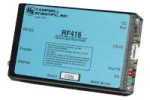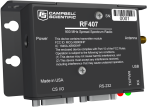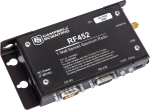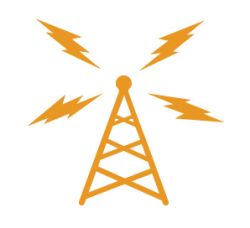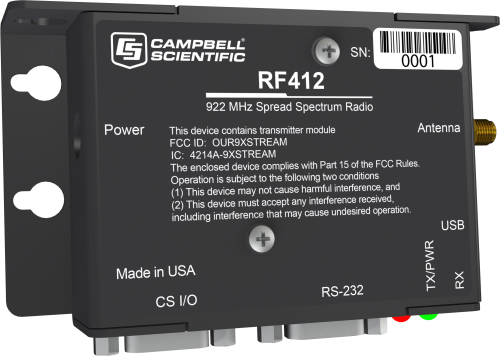
Overview
The RF412 is a high-speed 900 MHz serial radio designed for unlicensed operation in several countries, including Australia and New Zealand. The RF412 is a 915 to 928 MHz frequency-hopping spread-spectrum radio with a configurable transmit-power output of 5 to 250 mW and software-selectable channel masking for improved RF interference immunity. This power-sipping, yet speedy, radio provides a cost-effective way to network data loggers.
The RF412 is part of the RF407 series of radios that includes:
- RF407: North America (FCC & IC), 902 to 928 MHz
- RF412: Australia (ACMA RCM), 915 to 928 MHz
- RF422: Most of Europe and some of Asia (ETSI), 863 to 870 MHz
- RF427: Brazil (ANATEL), 905/920 MHz
Note to RF411A users: The RF411A is factory upgradeable to an RF412. Contact Campbell Scientific for a Returned Material Authorization (RMA).
Benefits and Features
- Does not require individual operational license in Australia or New Zealand
- High-speed serial communication, optimized for PakBus networks
- Low power (< 2 mA idle) during periods of inactivity
- Supports point-to-point with RF retries and point-to-multipoint operations
- Remote diagnostics using PakBus node operations
Images








Specifications
| Radio Type | Frequency Hopping Spread Spectrum (FHSS) |
| Frequency | 915 to 928 MHz |
| Country Used In | Australia, New Zealand |
| Transmission Distance |
|
| Power Output | 5 to 250 mW (software-selectable) |
| Receiver Sensitivity | -101 dBm |
| Channel Capacity | Eight 25-channel hop sequences sharing 31 available channels |
| Data Rate | 200 kbps |
| Link Throughput | 105 kbps (maximum) |
| Antenna Connector | Reverse Polarity SMA (RPSMA) jack |
| LEDs | Red TX/PWR and green RX |
| RS-232 Baud Rate | 1200 to 115200 bps |
| CS I/O Modes | SDC 7, 8, 10, 11, and ME master |
| Operating Temperature Range | -40° to +70°C |
| Power | 9 to 16 Vdc |
| Power Connector | 2.5 mm DC power jack |
| Average Current Drain |
|
| Communication Ports |
|
| Service Requirements | Shares frequency with other devices. Must not cause harmful interference to licensed radios. Requires line-of-sight. |
| Dimensions |
11.1 x 6.9 x 2.7 cm (4.4 x 2.7 x 1.1 in.) Dimension are from the tip of the antenna connector to the other side of the case, and from the bottom of the case to the top of the DB9 connector jack screw. The width includes the thickness of the screw heads on the screws that hold the case together. |
| Weight |
|
Certifications |
|
| Australia | ACMA RCM |
| United States (FCC Part 15.247) | MCQ-XB900HP |
| Industry Canada (IC) | 1846A-XB900HP |
Compatibility
Communications
The RF412 is over-the-air compatible with other RF412-based products. The RF412 can only communicate wirelessly with other RF412 radios and other Campbell Scientific products that have the "-RF412" option.
The RF412 is not over-the-air compatible with the RF411A. However, the RF411A is factory upgradeable to an RF412. Contact Campbell Scientific for a Returned Material Authorization (RMA).
Data Logger Considerations
| Data Logger | RS-232 | CS I/O |
| CR200(X) |  |
|
| CR800/CR850 |  |
 |
| CR1000 |  |
 |
| CR3000 |  |
 |
| CR5000 |  |
 |
| CR9000(X) |  |
|
| CR300 |  * * |
|
| CR6 |  |
 |
| CR510-PB |  |
|
| CR10X-PB |  |
|
| CR23X-PB |  |
|
| Mixed-array data loggers | ** |
Notes:
*Use a 18663 null modem cable.
**It is possible to connect a mixed-array data logger (e.g., CR10, CR10X, CR23X, 21X, CR7) by using an SC932A or SC105 between the data logger's CS I/O port and the RF412's RS-232 port.
Documents
Videos & Tutorials
Downloads
RF407, RF412, and RF427 Frequency Mask Calculator Spreadsheet v.1.0 (37 KB) 09-04-2025
The Frequency Mask Calculator lets you disable specific frequencies by setting their value to 0 in the MASK column. The resulting RF4XX frequency mask is then entered into your RF4XX settings, as directed in the calculator.
Case Studies
The Silkwood sugarcane water-quality monitoring site was established in 2014 as part of the Paddock......read more
Articles and Press Releases
Newsletter Articles
Privacy Policy Update
We've updated our privacy policy. Learn More
Cookie Consent
Update your cookie preferences. Update Cookie Preferences

